Thai pumpkin custard recipe (Sankaya Faktong) is a traditional Thai dessert with a harmonious blend of sweet and savory, featuring the rich flavors of kabocha squash, pandan leaves, and sweet coconut custard. You'll only need 6 ingredients to make this delightful dessert!

For more Thai pumpkin desserts using kabocha squash, try this popular dessert, Kabocha squash in coconut milk. More kabocha squash recipes you'll love are. Kabocha squash soup, Thai red curry with kabocha squash, and kabocha squash stir fry.
Learn more about Kabocha squash here (the only kind of Thai pumpkins used in Thai cuisine) and how to cut it. Read this helpful guide on kabocha and how to cut it here.
Jump to:
- Why You'll Love Thai Pumpkin Custard
- What is Thai Pumpkin Custard (Sankaya Faktong)
- What is kabocha Squash?
- Ingredients for making Sankaya Fakthong
- Extra Tips on Kabocha Squash and Palm Sugar
- How to Carve Kabocha Squash for Thai Pumpkin Dessert
- How to Make Thai Pumpkin Custard
- Presenting Your Custard
- Helpful Kitchen Notes and Tips
- Helpful Kitchen Tools for This Recipe
- How to Serve Sankaya Fak Tong
- Variations & Substitutes
- Storing Leftovers
- The many names of this Thai steamed pumpkin custard
- Frequently Asked Questions
- More of the reader's favorite desserts
- Thai Pumpkin Custard Recipe (Sankaya Faktong)
- More Kabocha Squash Recipes You'll Love
- Pairing
Why You'll Love Thai Pumpkin Custard
- A blend of indulgence and healthy kabocha squash makes this sweet dessert less guilty. It's the perfect dessert for those with a sweet tooth and satisfies the healthy eating crowd.
- A delightful presentation. This recipe is not something Western guests often see. It's not only beautiful but also a great conversational piece.
- A Fusion of Flavors: Thai Pumpkin Custard beautifully blends the earthy sweetness of pumpkin with the richness of coconut custard, creating a unique flavor profile that's hard to forget.
- Easy to Make: With just a handful of ingredients and straightforward steps.
- Versatile: Thai pumpkin custard can be served as a standalone dessert or paired with sticky rice for a more substantial treat.
What is Thai Pumpkin Custard (Sankaya Faktong)
Thai Pumpkin Custard, or Sankaya Faktong, is a beloved dessert in Thailand and other Southeast Asian countries. It features kabocha squash (Japanese pumpkin) as its star ingredient.
The pumpkin is hollowed out, filled with a sweet and creamy coconut custard mixture, and steamed to perfection. The result is a smooth, velvety dessert that tastes visually appealing and heavenly.
What is kabocha Squash?
Kabocha squash, also known as Kabocha pumpkins, Thai pumpkins, or Japanese pumpkins, is a popular variety of winter squash originating from Southeast Asia. It is beloved for its sweet and nutty flavor, making it a fantastic ingredient for various desserts.
If you're looking to find Kabocha squash, you can typically find it at your local Asian market.
Ingredients for making Sankaya Fakthong

- 1 (3 pounds) kabocha squash or 2 small squashes around 1.5 pounds each
- Coconut cream. Many recipes use coconut milk. I prefer coconut cream for my desserts for the extra creaminess.
- White sugar. Traditionally, palm sugar is used in this recipe. I prefer the white sugar. See the section below for extra tips on this.
- Eggs. This is where the heart and soul of the custard is. Use good quality eggs if possible.
- Pandan leaves, fresh or frozen. Or 4-5 drops of vanilla or pandan extract
- Salt. Salt adds a touch of balance to the sweetness of this dessert.
Extra Tips on Kabocha Squash and Palm Sugar
I prefer using white sugar instead of palm sugar. While palm sugar is traditionally used and preferred, it makes my custard flavors a bit flat because I use coconut cream instead of coconut milk.
Also, The kabocha squash found in regular grocery stores in the US can be harder to come by during the off-season and may have a slightly bitter aftertaste due to the older shelf life of the squash. Palm sugar's lighter and less sharp taste allows the kabocha flavor to overpower the custard.
If you prefer, you can use brown sugar as a substitute for Thai palm sugar. I prefer the aesthetic of using white sugar as it gives my custard a cleaner look.
Palm or brown sugar can be used during pumpkin season or when using younger kabocha squash. Experiment with different sugar options to find the best fit for your taste buds.
How to Carve Kabocha Squash for Thai Pumpkin Dessert
Feel free to carve the top of your pumpkin into any shape you desire, just like you would with a regular pumpkin!


- To carve a Kabocha squash, firmly hold it down with the palm of your hand on a cutting board.
- Use a medium-sharp knife to cut around the top of the pumpkin to create a lid. Save the pumpkin lid to steam with the custard and use it as a lid for a fun presentation at serving.
- Scrape the inside of the kabocha pumpkin with a spoon, removing all fibers and seeds. Rinse and let it dry before filling it with raw custard.
- Carefully smooth any bumps or sharp edges on the exterior with the knife. Be cautious not to cut too hard and cause the squash to split while steaming.
How to Make Thai Pumpkin Custard
Step 1: Prepare the Kabocha Squash. Start by washing your squash well and scrape off any rough bits and pieces on the exterior.
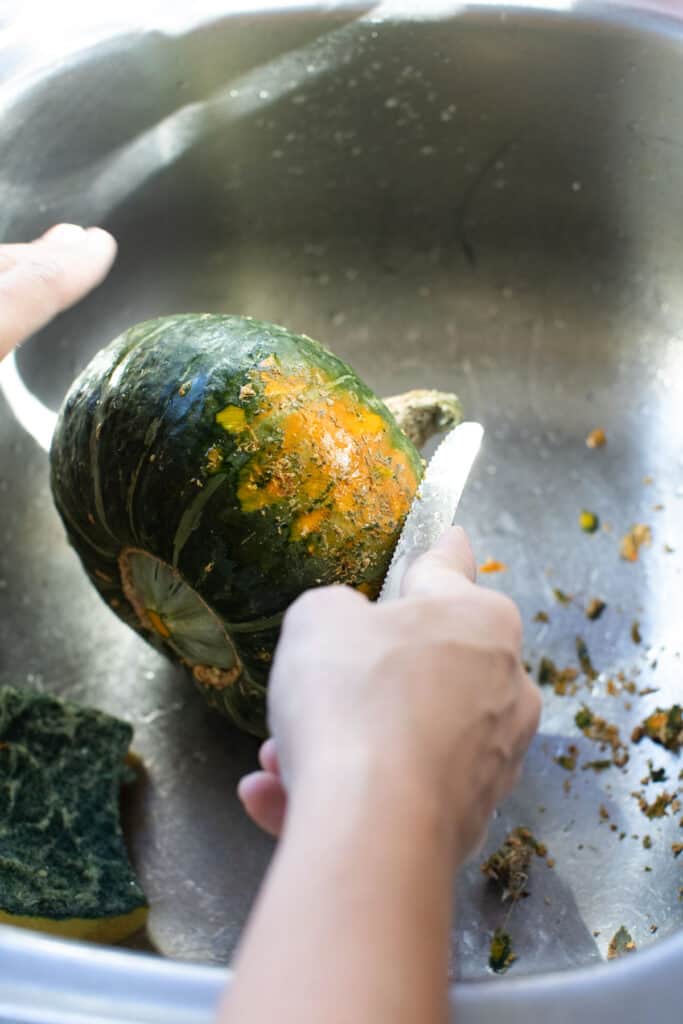

Step 2. Carve the squash. Next, cut off the top of the kabocha squash to create a lid. See the instructions above. Use a spoon to scoop out the seeds and stringy fibers from the inside. You'll want a clean, hollow pumpkin ready to be filled with the raw custard mixture.

Step 3: Create the Custard Mixture. Combine coconut milk, sugar, eggs, pandan leaves, and a pinch of salt in a mixing bowl. Massage the mixture with your fingers until the ingredients form a smooth, creamy custard mixture.
Using hand gloves is handy for this step. Remove the pandan leaves and whisk the eggs for a more smooth texture.

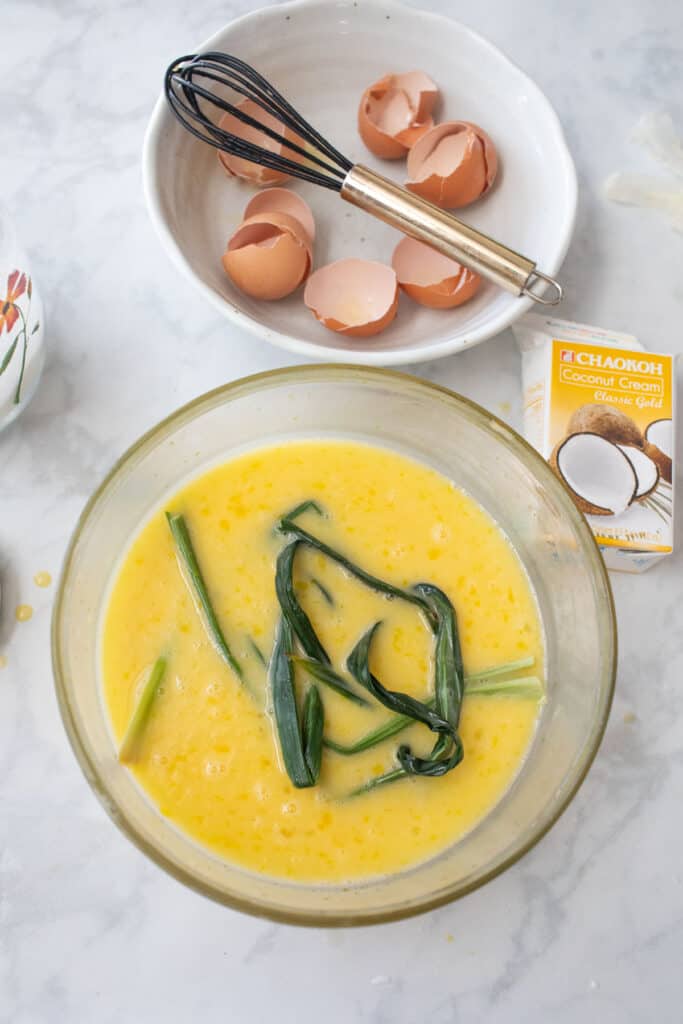

Step 4: Fill the Pumpkin. Pour the custard mixture into the hollowed-out kabocha squash. Be sure not to overfill, leaving some space at the top as the custard will expand and fill out as you steam it.

Step 5: Steam the Pumpkin. Place the filled kabocha squash in a steamer pan or basket, cover the pot with a lid, and steam over medium heat for about 30-45 minutes or until the custard is set.
You can insert a toothpick or knife into the corner part of the custard to check for doneness; it should come out clean.


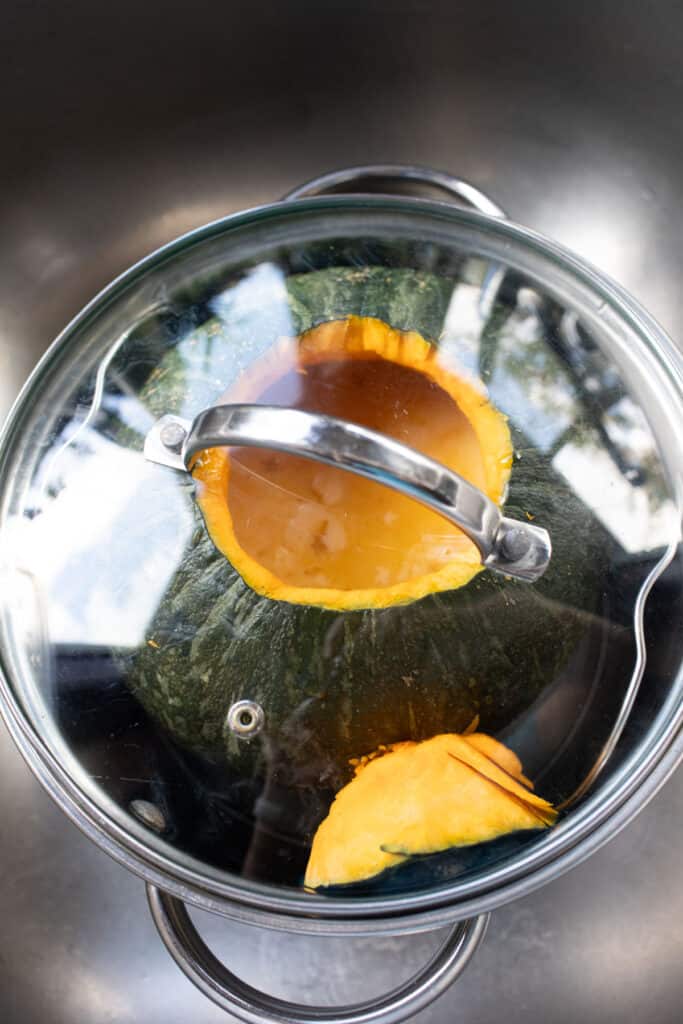
Step 6: Cool and Serve. Once the pumpkin custard is done, allow it to cool to room temperature. Slice and serve the dessert, and enjoy the rich, creamy goodness.
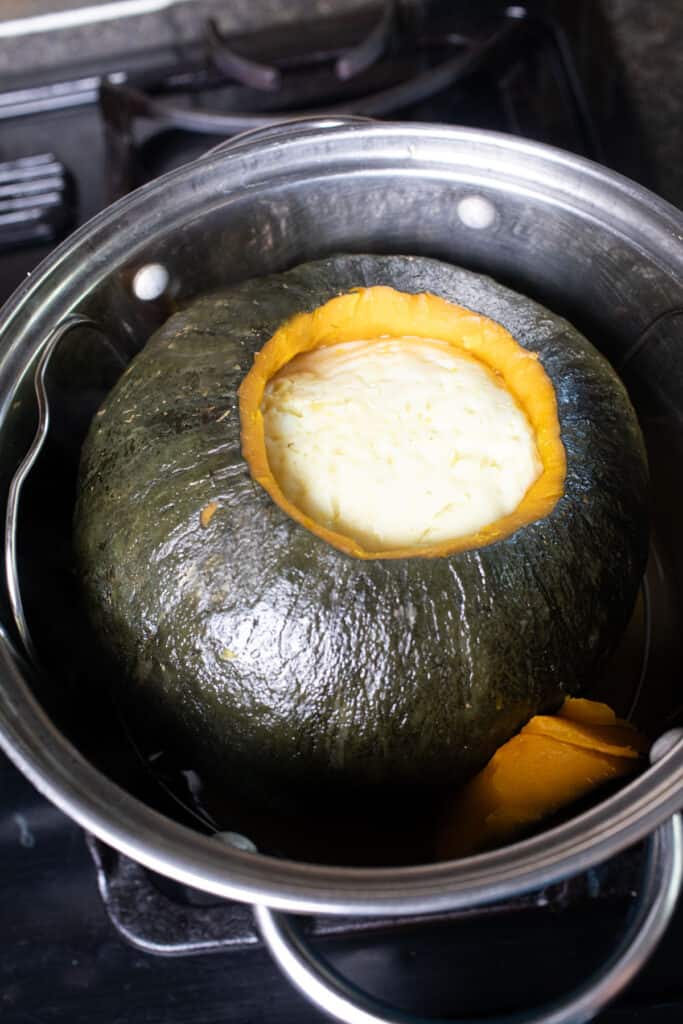
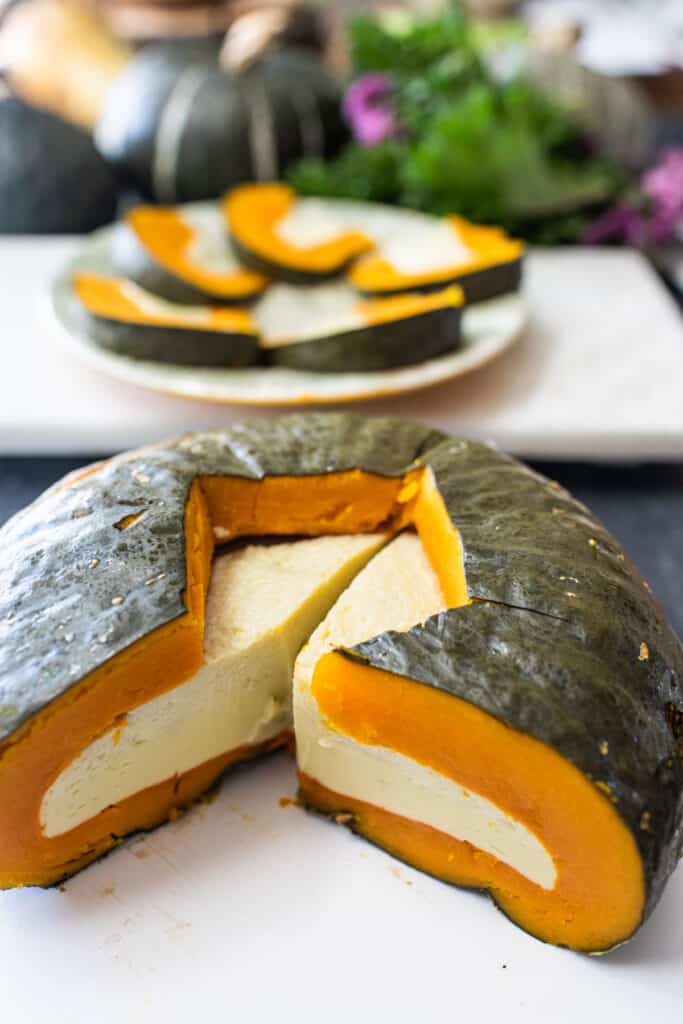
Presenting Your Custard
You can enhance the presentation of your Thai pumpkin custard with edible leaves or flowers. Add a sprinkle of toasted desiccated coconut or a drizzle of extra coconut milk for garnishing.
Helpful Kitchen Notes and Tips
- When using a smaller steamer, make sure the water doesn't touch the squash. Keep an eye on the pot to prevent burning.
- Use a timer to check every 10 minutes and add water in 1-cup increments. The steaming time should be increased by 5-10 minutes to account for the cooling effect of the water.
- Just cut around the pumpkin and use the pretty pieces if the pumpkin splits. It's common, and there's no stress if yours split. (:
- Use a tight, heat-safe steamer basket or bowl. Aluminum foil can also be used to hold the pumpkin tight.
Helpful Kitchen Tools for This Recipe
(These suggested helpful items are affiliate links, and I earn a small commission from your purchase. You will not be charged extra for these items.)
- To create this Thai dessert, you'll need a steamer basket to cook the pumpkin custard gently.
- A caraway steamer. My favorite for my caraway pot.
- A multi-purpose stainless steel steamer.
- For a smoother custard, strain the mixture through a cheesecloth before filling the kabocha squash to remove lumps.
- Sticky rice steamer basket. If you have this set, use it. The narrow basket helps hold the pumpin together without splitting.
How to Serve Sankaya Fak Tong
Thai Pumpkin Custard is delicious on its own. Sometimes, it's served with sweet sticky rice for a satisfying and filling dessert. The same sticky rice you use for the mango sticky rice recipe.
Variations & Substitutes
- You can experiment with different pumpkins or squashes if kabocha squash is unavailable. Each variety will bring its unique flavor to the dessert.
- For sugar, try experimenting with palm, brown, or coconut sugar.
- For an even healthier option, use monk fruit sugar. Use a 1-1 ratio, and it tastes great!
Storing Leftovers
Store any leftover Thai Pumpkin Custard in the refrigerator in an airtight container, which will be good for up to 3 days. It can be enjoyed cold or gently reheated before serving.
The many names of this Thai steamed pumpkin custard
This Thai recipe has many names.
You might see Sangkaya Fak Thong, Sankaya Fak Thong, Sangkhaya Fak Thong, Fak Tong Sankaya, Thai sweet custard, or Thai pumpkin custard. They are the same thing. The method and preparation might differ slightly from place to place, but they are the same dessert.
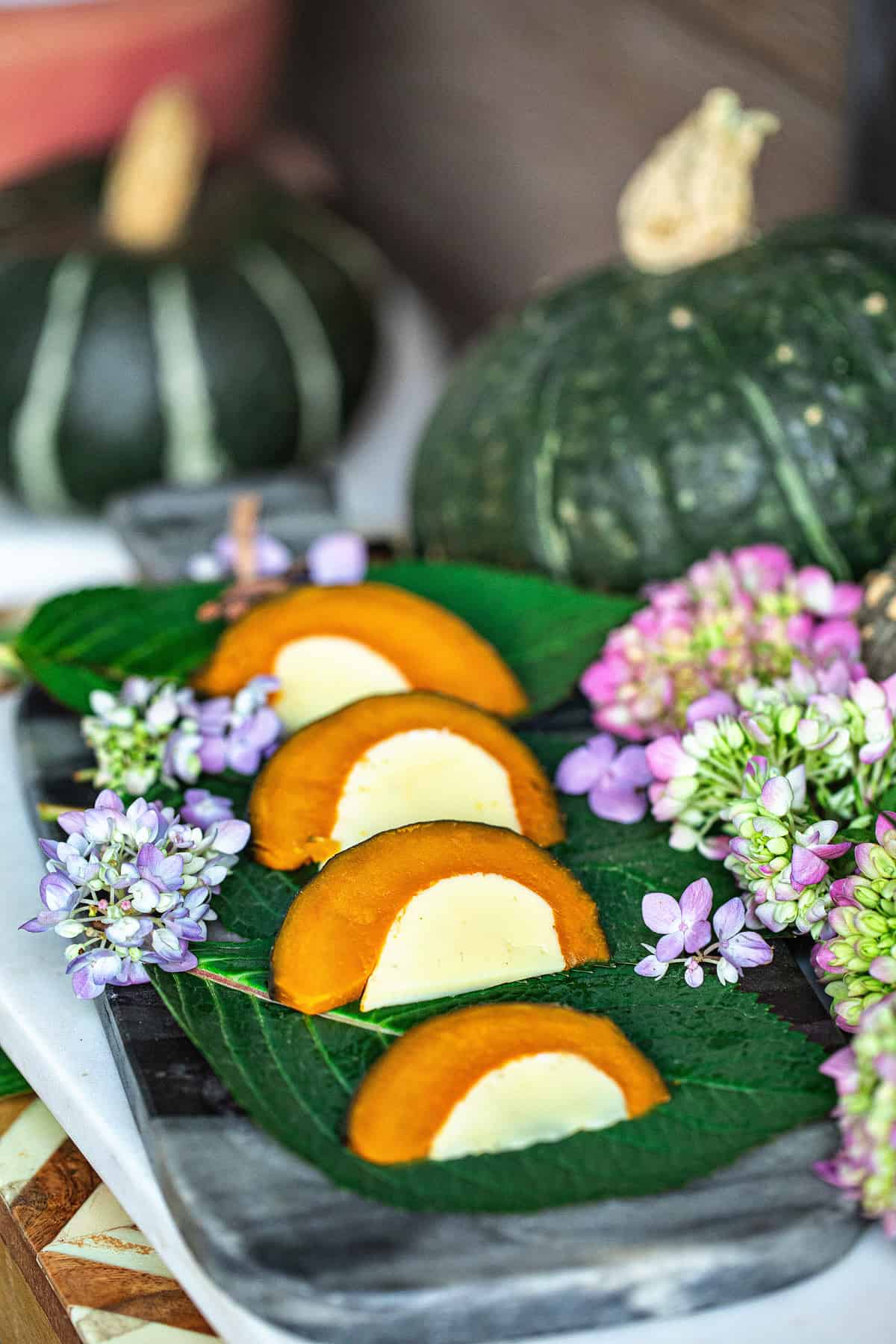
Frequently Asked Questions
Kabocha squash, or Japanese pumpkin, is the traditional choice for Thai Pumpkin Custard due to its sweet, velvety texture. However, you can experiment with other pumpkin or squash varieties as well.
Yes, feel free to adjust the sweetness by using more or less sugar to suit your taste.
Thai Pumpkin Custard is best enjoyed fresh, but you can make the custard mixture in advance and fill the kabocha squash just before steaming.
Yes, you can. But for this recipe, Custards made with egg yolks can be overwhelming in taste and overly thick and creamy in texture. If this is what you want, use coconut milk instead of coconut cream to help balance the delicate flavors that make this custard truly exceptional.
No. This specific recipe uses whole kabocha squash. However, there are other variations of this dessert using thinly sliced kabocha or pureed kabocha squash
More of the reader's favorite desserts
- Kabocha squash in coconut milk
- Mango sticky rice
- Mango Sago
- Thai coconut ice cream
- Thai tea ice cream
**Love a recipe you've tried? Please leave a 5-star rating in the recipe card below and a review in the comments section further down the page. Or follow me on Facebook, Pinterest, or Instagram!**
Print
Thai Pumpkin Custard Recipe (Sankaya Faktong)
- Total Time: 45 minutes
- Yield: 12
- Diet: Gluten Free
Description
Thai pumpkin custard recipe (Sankaya Faktong) is a traditional Thai dessert with a harmonious blend of sweet and savory, featuring the rich flavors of kabocha squash, pandan leaves, and sweet coconut custard. You'll only need 6 ingredients to make this delightful dessert!
Ingredients
- 1 kabocha squash (around 3 pounds) or 2 small ones around 1.5 pounds each
- 1 cup coconut cream
- 1 cup sugar
- 5 eggs
- 3 pandan leaves, fresh or frozen. Or 4-5 drops of vanilla or pandan extract. Find these at the Asian markets in the fresh or frozen section.
- ½ teaspoon salt
Instructions
- Prepare the Kabocha Squash. Start by washing your squash well and scrape off any rough bits and pieces on the exterior.
- Carve the squash. Next, cut off the top of the kabocha squash to create a lid. See the instructions below. Use a spoon to scoop out the seeds and stringy fibers from the inside. You'll want a clean, hollow pumpkin ready to be filled with the raw custard mixture.
- Create the Custard Mixture. Combine coconut milk, sugar, eggs, pandan leaves, and a pinch of salt in a mixing bowl. Massage the mixture with your fingers until the ingredients form a smooth, creamy custard mixture. Using hand gloves is handy for this step. Remove the pandan leaves and whisk the eggs for a more smooth texture.
- Fill the Pumpkin. Pour the custard mixture into the hollowed-out kabocha squash. Be sure not to overfill, leaving some space at the top as the custard will expand and fill out as you steam it.
- Steam the Pumpkin. Place the filled kabocha squash in a steamer pan or basket, cover the pot with a lid, and steam over medium heat for about 30-45 minutes or until the custard is set. You can insert a toothpick or knife into the corner part of the custard to check for doneness; it should come out clean.
- Cool and Serve. Once the pumpkin custard is done, allow it to cool to room temperature. Slice and serve the dessert, and enjoy the rich, creamy goodness.
Presenting and serving your custard: You can enhance the presentation of your Thai pumpkin custard with edible leaves or flowers. Add a sprinkle of toasted desiccated coconut or a drizzle of extra coconut milk for garnishing.
How to carve a kabocha squash:
- To carve a Kabocha squash, firmly hold it down with the palm of your hand on a cutting board.
- Use a medium-sharp knife to cut around the top of the pumpkin to create a lid. Save the pumpkin lid to steam with the custard and use it as a lid for a fun presentation at serving.
- Scrape the inside of the kabocha pumpkin with a spoon, removing all fibers and seeds. Rinse and let it dry before filling it with raw custard.
- Carefully smooth any bumps or sharp edges on the exterior with the knife. Be cautious not to cut too hard and cause the squash to split while steaming.
* Feel free to carve the top of your pumpkin into any shape you desire, just like you would with a regular pumpkin!
Notes
- When using a smaller steamer, make sure the water doesn't touch the squash. Keep an eye on the pot to prevent burning.
- Use a timer to check every 10 minutes and add water in 1-cup increments. The steaming time should be increased by 5-10 minutes to account for the cooling effect of the water.
- Just cut around the pumpkin and use the pretty pieces if the pumpkin splits. It's common, and there's no stress if yours split.
- Use a tight, heat-safe steamer basket or bowl. Aluminum foil can also be used to hold the pumpkin tight.
- If you have leftover custard, steam in a ramekin until the custard is cooked through!
** Thank you so much for visiting my blog! This is truly a passion for me. If you have enjoyed these recipes and appreciate the hard work I put into them, I would love it if you would share them with your friends! Your recommendation is the highest review I could hope for, and I’d appreciate it! **
- Prep Time: 15
- Cook Time: 30
- Category: Desserts
- Method: steaming
- Cuisine: Thai
More Kabocha Squash Recipes You'll Love
Pairing
These are my favorite dishes to serve with kabocha squash desserts as a set in a family meal.

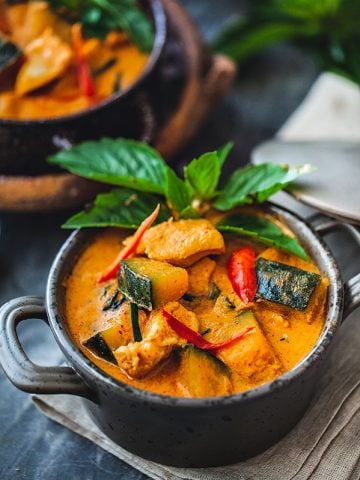
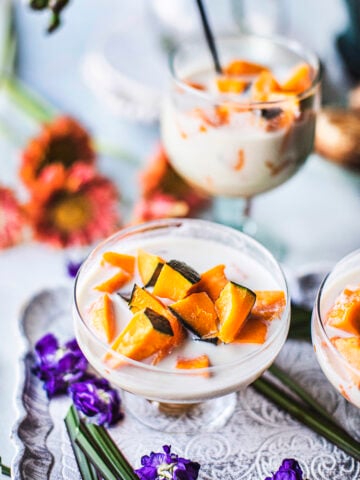

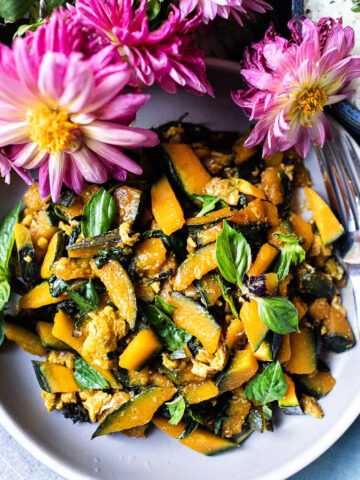

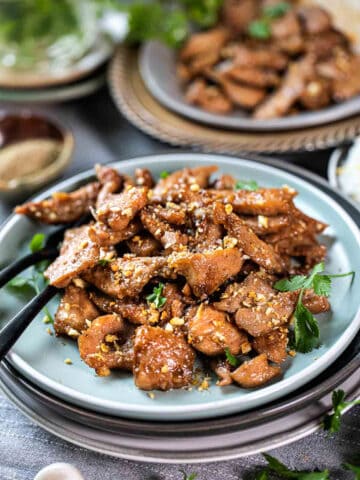


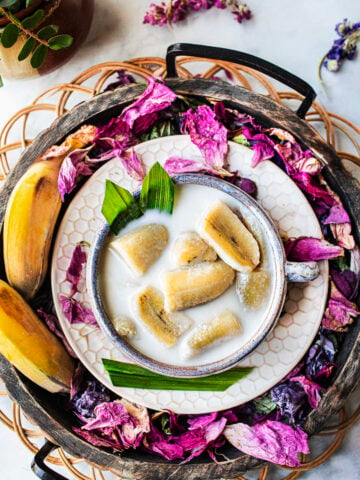



Claire says
Never had them before trying the recipe but it turned out wonderful. I love the taste and the texture of it. Will make it again soon.
Amy says
My favorite! It was a perfect blend between the custard and the squash.